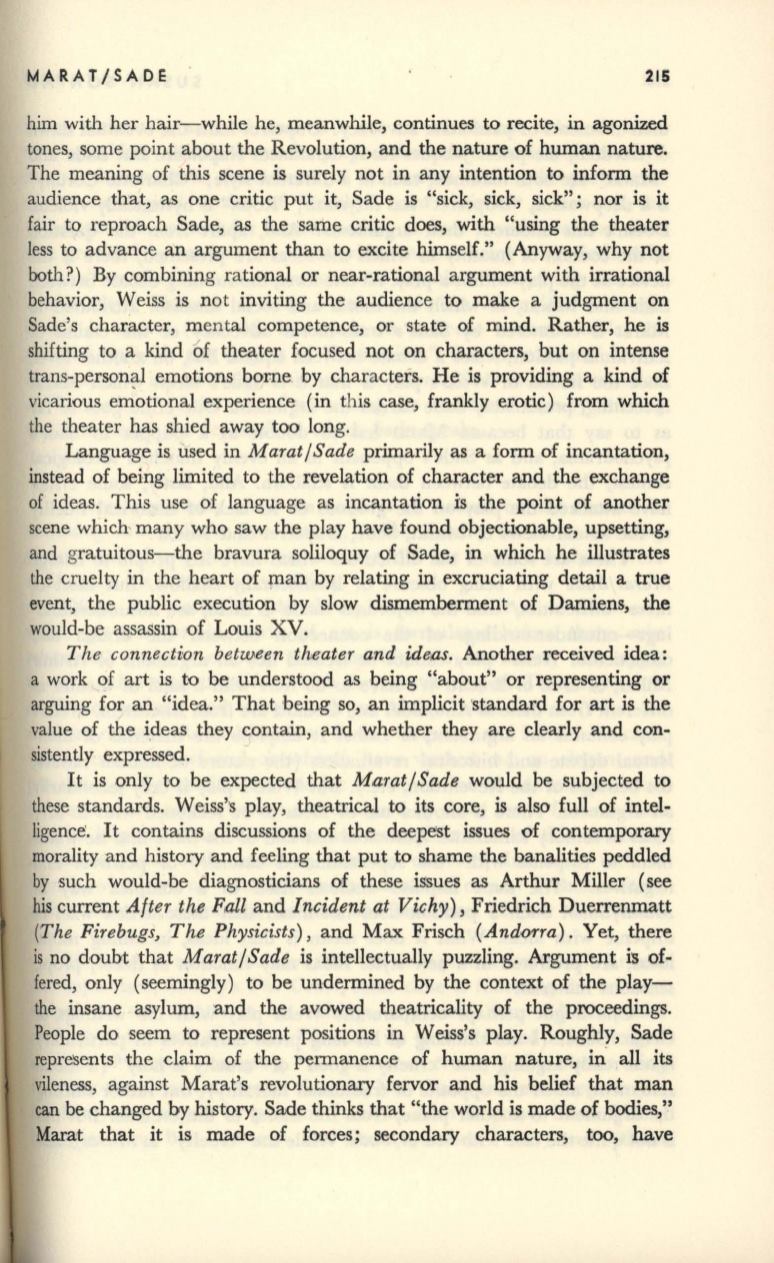
MARAT/SADE
215
him with her hair-while he, meanwhile, continues to recite, in agonized
tones, some point about the Revolution, and the nature of human nature.
The meaning of this scene
is
surely not in any intention to inform the
audience that, as one critic put it, Sade is "sick, sick, sick"; nor is it
fair to repl'Oach Sade, as the same critic does, with "using the theater
less to advance an argument than to excite himself." (Anyway, why not
both?) By combining rational or near-rational argument with irrational
behavior, Weiss is not inviting the audience to make a judgment on
Sade's character, men tal competence, or state of mind. Rather, he
is
shifting to a kind of theater focused not on characters, but on intense
trans-personal emotions borne by characters. He is providing a kind of
vicarious ern'otional experience (in this case, frankly erotic) from which
the theater has shied away too long.
Language is used in
Marat/Sade
primarily as a form of incantation,
instead of being limited to the revelation of character and the exchange
of ideas. This use of language as incantation is the point of another
scene which many who saw the play have found objectionable, upsetting,
and gratuitous-the bravura soliloquy of Sade, in which he illustrates
the cruelty in the heart of fIlan by relating in excruciating detail a true
event, the public execution by slow dismemberment of Damiens,
the
would-be assassin of Louis XV.
The connecti'on between theater and ideas.
Another received idea:
a work of art is to be understood as being "about" or representing or
arguing for an "idea." That being so, an implicit 'standard for
art
is the
value of the ideas they contain, and whether they are clearly and con–
sistently expressed.
It is only to be expected that
Marat/Sade
would be subjected to
these standards. Weiss's play, theatrical to its core,
is
also full of intel–
ligence'. It contains discussions of the deepest issues of contemporary
morality and history and feeling that put to shame the banalities peddled
by such would-be diagnosticians of these issues as Arthur Miller (see
his
current
After the Fall
and
Incident at Vichy),
Friedrich Duerrenmatt
(The Firebugs, The Physicists),
and Max Frisch
(Andorra).
Yet, there
is no doubt that
Marat/Sade
is intellectually puzzling. Argument is of–
fered, only (seemingly) to be undermined by the context of the play–
the insane asylum, and the avowed theatricality of the proceedings.
People do seem to represent positions in Weiss's play. Roughly, Sade
represents the claim of the permanence of human nature, in all
its
vileness, against Marat's revolutionary fervor and his belief that man
can be changed by history. Sade thinks that "the world is made of bodies,"
Marat that it is made of forces; secondary characters, too, have


